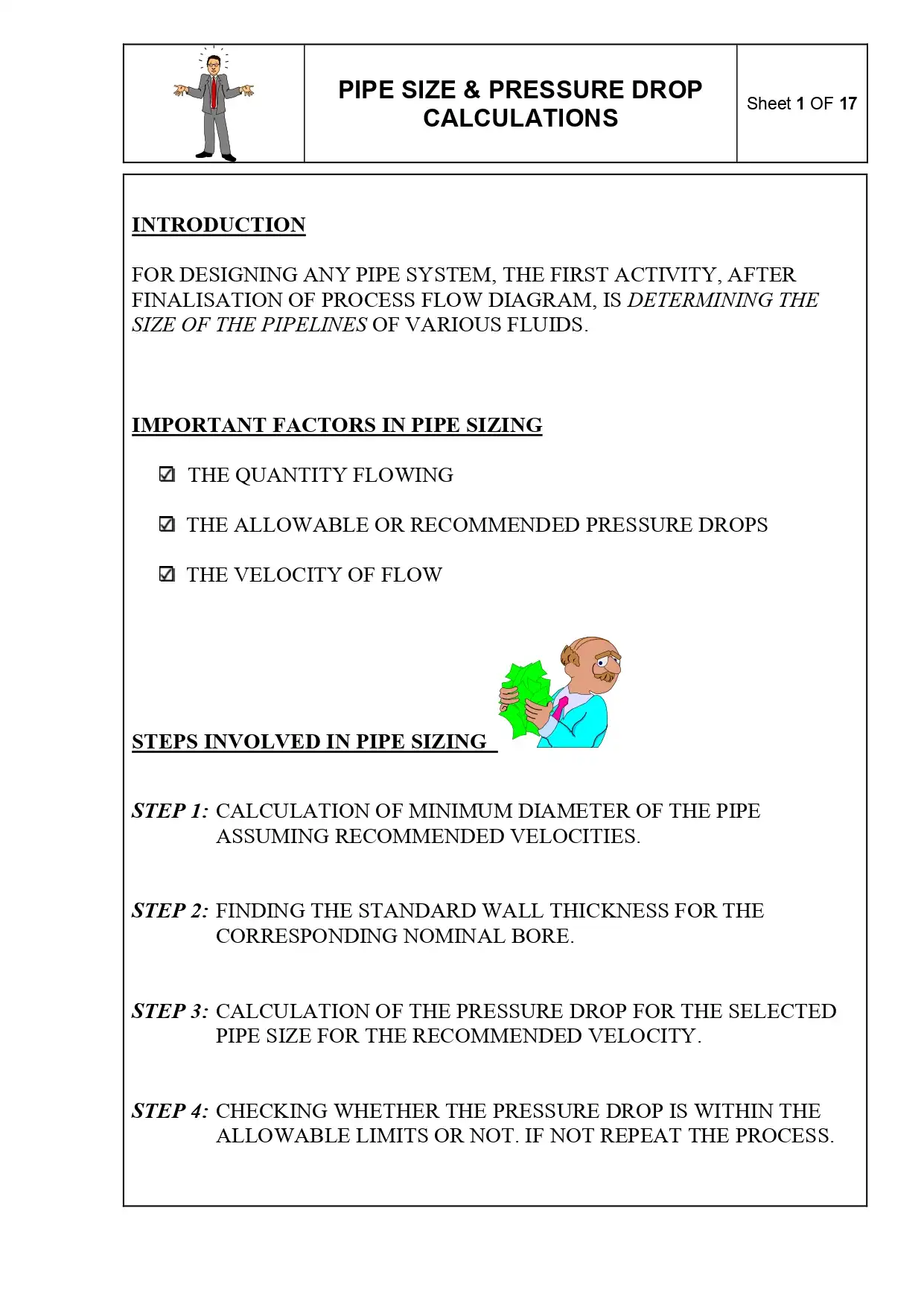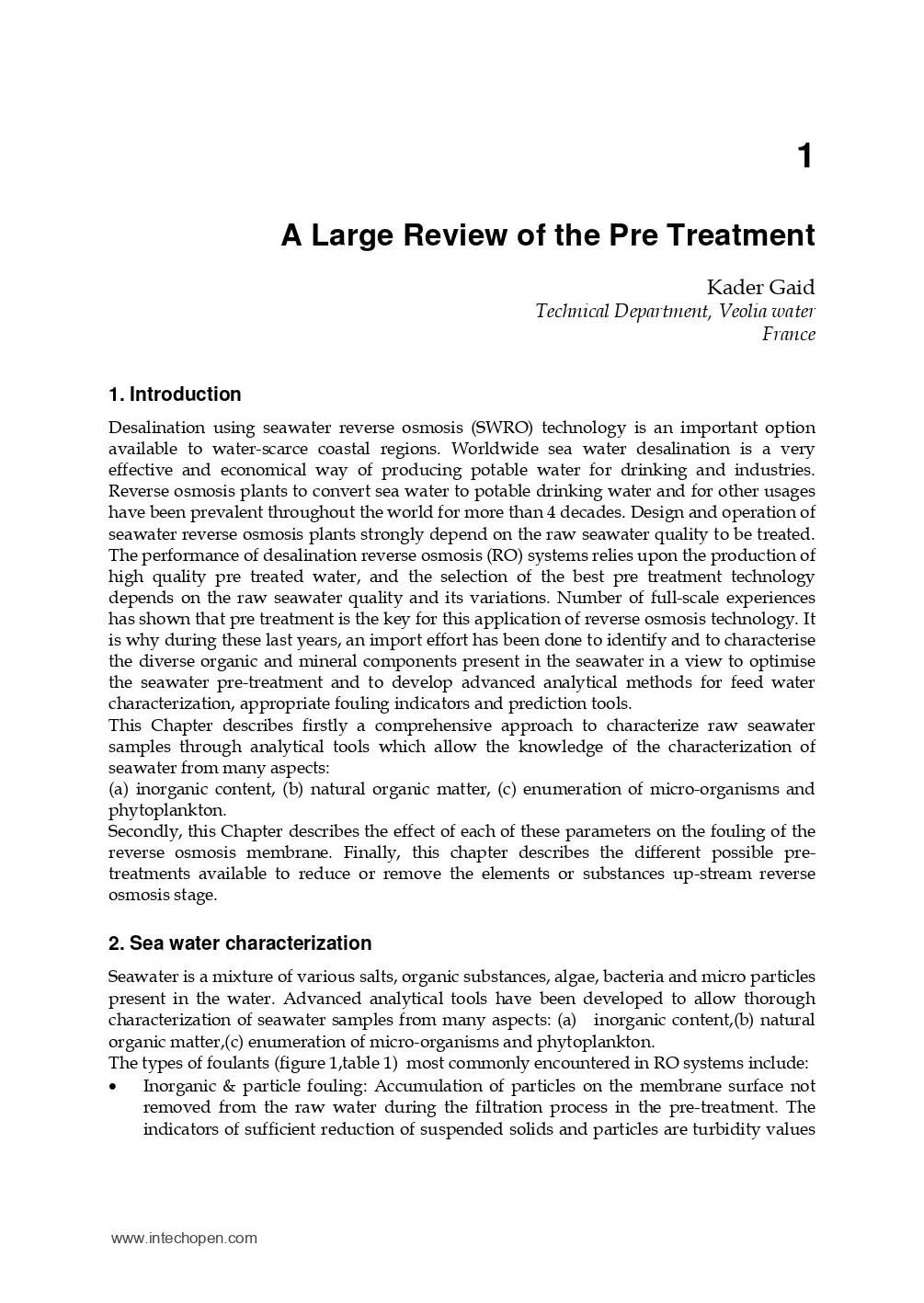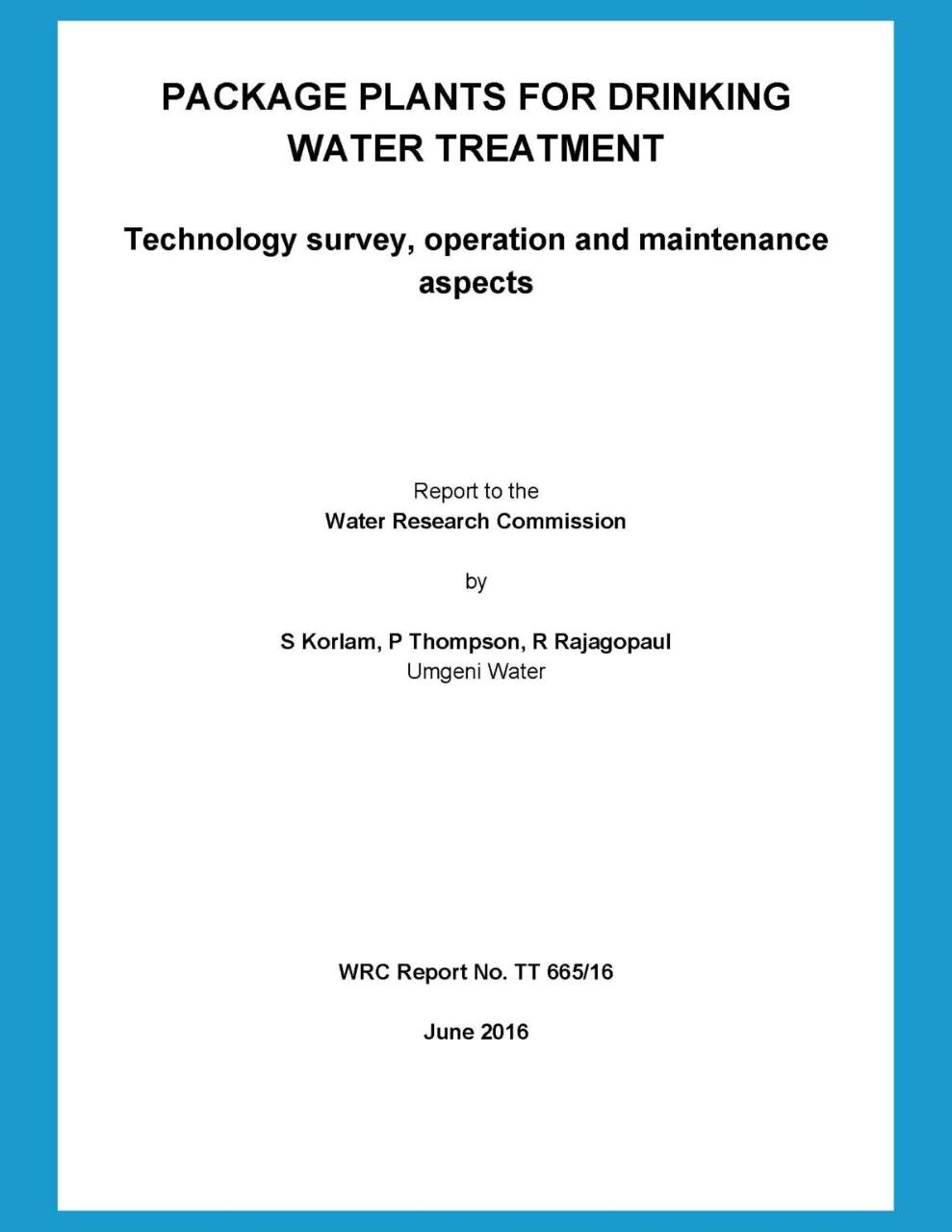Pipe Size & Pressure Drop Calculations
Usually dispatched in 2 to 3 days
Usually dispatched in 2 to 3 days
Categories:
Drinking Water Treatment, Hydraulic , Piping & Fittings
Only logged in customers who have purchased this product may leave a review.
Related products
Recommended Standards for Water Works
A Report of the Water Supply Committee of the Great Lakes--Upper Mississippi River Board
of State and Provincial Public Health and Environmental Managers
Recommended Standards for Water Works
A Report of the Water Supply Committee of the Great Lakes--Upper Mississippi River Board
of State and Provincial Public Health and Environmental Managers
A Study on the Introduction of Artificial Intelligence Technology in the Water Treatment Process
Today, we stand in front of a huge wave of change named the "Fourth industrial revolution." Key technologies of the Fourth Industrial Revolution include artificial intelligence, the Internet of Thing (IoT), cloud computing, big data analysis, etc. These technologies will lead to an intelligent information society, and platform services will change every aspect of society from economic and work. This paper proposes several introductions of Artificial Intelligence Technology to improve water management.
A Study on the Introduction of Artificial Intelligence Technology in the Water Treatment Process
Today, we stand in front of a huge wave of change named the "Fourth industrial revolution." Key technologies of the Fourth Industrial Revolution include artificial intelligence, the Internet of Thing (IoT), cloud computing, big data analysis, etc. These technologies will lead to an intelligent information society, and platform services will change every aspect of society from economic and work. This paper proposes several introductions of Artificial Intelligence Technology to improve water management.
A Large Review of the Pre Treatment
Introduction:
Desalination using seawater reverse osmosis (SWRO) technology is an important option available to water-scarce coastal regions. Worldwide sea water desalination is a very effective and economical way of producing potable water for drinking and industries. Reverse osmosis plants to convert sea water to potable drinking water and for other usages have been prevalent throughout the world for more than 4 decades. Design and operation of seawater reverse osmosis plants strongly depend on the raw seawater quality to be treated. The performance of desalination reverse osmosis (RO) systems relies upon the production of high quality pre treated water, and the selection of the best pre treatment technology depends on the raw seawater quality and its variations. Number of full-scale experiences has shown that pre treatment is the key for this application of reverse osmosis technology. It is why during these last years, an import effort has been done to identify and to characterise the diverse organic and mineral components present in the seawater in a view to optimise the seawater pre-treatment and to develop advanced analytical methods for feed water characterization, appropriate fouling indicators and prediction tools. This Chapter describes firstly a comprehensive approach to characterize raw seawater samples through analytical tools which allow the knowledge of the characterization of seawater from many aspects: (a) inorganic content, (b) natural organic matter, (c) enumeration of micro-organisms and phytoplankton. Secondly, this Chapter describes the effect of each of these parameters on the fouling of the reverse osmosis membrane. Finally, this chapter describes the different possible pre treatments available to reduce or remove the elements or substances up-stream reverse osmosis stage.
A Large Review of the Pre Treatment
Introduction:
Desalination using seawater reverse osmosis (SWRO) technology is an important option available to water-scarce coastal regions. Worldwide sea water desalination is a very effective and economical way of producing potable water for drinking and industries. Reverse osmosis plants to convert sea water to potable drinking water and for other usages have been prevalent throughout the world for more than 4 decades. Design and operation of seawater reverse osmosis plants strongly depend on the raw seawater quality to be treated. The performance of desalination reverse osmosis (RO) systems relies upon the production of high quality pre treated water, and the selection of the best pre treatment technology depends on the raw seawater quality and its variations. Number of full-scale experiences has shown that pre treatment is the key for this application of reverse osmosis technology. It is why during these last years, an import effort has been done to identify and to characterise the diverse organic and mineral components present in the seawater in a view to optimise the seawater pre-treatment and to develop advanced analytical methods for feed water characterization, appropriate fouling indicators and prediction tools. This Chapter describes firstly a comprehensive approach to characterize raw seawater samples through analytical tools which allow the knowledge of the characterization of seawater from many aspects: (a) inorganic content, (b) natural organic matter, (c) enumeration of micro-organisms and phytoplankton. Secondly, this Chapter describes the effect of each of these parameters on the fouling of the reverse osmosis membrane. Finally, this chapter describes the different possible pre treatments available to reduce or remove the elements or substances up-stream reverse osmosis stage.
Big Data Analysis For Studying Water Supply And Sanitation Coverage In Cities (Russia)
Big data analysis for water supply and sanitation is important for ensuring urban viability. Our research is devoted to studying the methodology for analyzing big data of the water supply and sanitation systems. Based on a review of scientific publications and their analysis, a model for analyzing large data was proposed. It comprises information sources, data collection and storage platforms with indication of parameters for the programming model, runtime and
storage environment, as well as data analysis and processing.
Big Data Analysis For Studying Water Supply And Sanitation Coverage In Cities (Russia)
Big data analysis for water supply and sanitation is important for ensuring urban viability. Our research is devoted to studying the methodology for analyzing big data of the water supply and sanitation systems. Based on a review of scientific publications and their analysis, a model for analyzing large data was proposed. It comprises information sources, data collection and storage platforms with indication of parameters for the programming model, runtime and
storage environment, as well as data analysis and processing.
Package Plants For Drinking Water Treatment
In efforts to make package plants more compact, affordable and easier to operate and maintain, it has been noted that the design and performance of some of these plants containing conventional treatment processes is sometimes compromised if technical expertise in this regard is lacking. Generally, there are several risks associated with poorly designed treatment systems, including loss of production, poor safety and compromised equipment and process unit efficiency with associated higher operating and maintenance costs. These risks have more severe consequences in the case of desalination (including water reclamation and water re-use) package plants. The objective of this project is to develop a set of guidelines to assist municipalities, water treatment practitioners, designers and package plant manufacturers in the specification and design of appropriate unit processes and operating parameters to fit the influent water quality, operating environment and other special treatment requirements.
Package Plants For Drinking Water Treatment
In efforts to make package plants more compact, affordable and easier to operate and maintain, it has been noted that the design and performance of some of these plants containing conventional treatment processes is sometimes compromised if technical expertise in this regard is lacking. Generally, there are several risks associated with poorly designed treatment systems, including loss of production, poor safety and compromised equipment and process unit efficiency with associated higher operating and maintenance costs. These risks have more severe consequences in the case of desalination (including water reclamation and water re-use) package plants. The objective of this project is to develop a set of guidelines to assist municipalities, water treatment practitioners, designers and package plant manufacturers in the specification and design of appropriate unit processes and operating parameters to fit the influent water quality, operating environment and other special treatment requirements.
Biological Biofilm Processes
•Used for removal of organic pollutants from wastewaters
•Biological treatment is popular due to:
–low cost
–effective in removal of a wide range of organic contaminants
–effective in removal of colloidal organics
–can remove toxic non-organic pollutants such as heavy metals
Biological Biofilm Processes
•Used for removal of organic pollutants from wastewaters
•Biological treatment is popular due to:
–low cost
–effective in removal of a wide range of organic contaminants
–effective in removal of colloidal organics
–can remove toxic non-organic pollutants such as heavy metals
Advancing Water, Sanitation and Hygiene (WASH) in Panchayats
Access to safe drinking water is critical to survival, and its deprivation could affect the health, food security, and livelihoods of human beings. India achieved 93% coverage of access to improved water supply in rural areas in 2015 towards fulfilling its commitment under the Millennium Development Goal1. However, with reference to safely managed drinking water (improved water supply located on-premises, available when needed and free of contamination) as per Sustainable Development Goal, India still has major targets to achieve, and is geared up to accomplish the same by the end of 2024. With the shift from the Millennium Development Goals (MDGs) to the Sustainable Development Goals (SDGs) less than half of the total rural households in the country have access to safely managed drinking water (improved water supply located on-premises, available when needed and free of contamination).
Advancing Water, Sanitation and Hygiene (WASH) in Panchayats
Access to safe drinking water is critical to survival, and its deprivation could affect the health, food security, and livelihoods of human beings. India achieved 93% coverage of access to improved water supply in rural areas in 2015 towards fulfilling its commitment under the Millennium Development Goal1. However, with reference to safely managed drinking water (improved water supply located on-premises, available when needed and free of contamination) as per Sustainable Development Goal, India still has major targets to achieve, and is geared up to accomplish the same by the end of 2024. With the shift from the Millennium Development Goals (MDGs) to the Sustainable Development Goals (SDGs) less than half of the total rural households in the country have access to safely managed drinking water (improved water supply located on-premises, available when needed and free of contamination).
Removal of Aluminium from Drinking Water
Aluminium in drinking water comes from natural sources and the alum used as coagulant in the water treatment process. Exposure to aluminium has been implicated in dialysis dementia, Parkinson and Alzheimer’s disease. Drinking water containing aluminium was considered to be one of the main sources of Al intake into human body. For this reason, the removal of aluminium from drinking water is vital to our health. In this study, removal of aluminium was carried out by using a chelating resin.
Removal of Aluminium from Drinking Water
Aluminium in drinking water comes from natural sources and the alum used as coagulant in the water treatment process. Exposure to aluminium has been implicated in dialysis dementia, Parkinson and Alzheimer’s disease. Drinking water containing aluminium was considered to be one of the main sources of Al intake into human body. For this reason, the removal of aluminium from drinking water is vital to our health. In this study, removal of aluminium was carried out by using a chelating resin.
Inorganic Contaminant Removal
The 2006 version of the Pa. DEP Inorganic Contaminant Removal module has detailed advanced treatment information on this topic and can be obtained by e-mailing the Pa. DEP Safe Drinking Water Training Section at DEPWSTechtrain@pa.gov to request a copy. This advanced module has additional information on the removal of various inorganic contaminants as well as on oxidation, ion exchange, activated alumina and sequestration. The 2006 document also includes more detailed information on the inorganic contaminant treatments of GAC (granular activated carbon), coagulation/filtration, membranes, and lime softening. It includes the following information:
- Inorganic contaminant treatment selection considerations
- Advanced inorganic contaminant removal chemistry terminology
- Advanced inorganic contaminant removal chemistry explanations
- Conventional filtration and how it relates to inorganic removal
- Detailed information on treatments for iron and manganese removal
- Detailed information on treatments for hardness removal
- Detailed information on inorganic contaminant monitoring protocols
- Detailed tables on the following topics:
- Sources of 26 inorganic contaminants
- Common secondary standards with effects, inorganic contributors and indications
- Various treatment technology options to consider for 24 inorganic contaminants
- Potential forms of iron and manganese
- Iron and manganese sampling procedures
- Iron and manganese oxidant selection criteria
- Iron and manganese theoretical (initial) dosing criteria
- Potential treatments for less common inorganics
- Potential treatments for miscellaneous trace metals
Inorganic Contaminant Removal
The 2006 version of the Pa. DEP Inorganic Contaminant Removal module has detailed advanced treatment information on this topic and can be obtained by e-mailing the Pa. DEP Safe Drinking Water Training Section at DEPWSTechtrain@pa.gov to request a copy. This advanced module has additional information on the removal of various inorganic contaminants as well as on oxidation, ion exchange, activated alumina and sequestration. The 2006 document also includes more detailed information on the inorganic contaminant treatments of GAC (granular activated carbon), coagulation/filtration, membranes, and lime softening. It includes the following information:
- Inorganic contaminant treatment selection considerations
- Advanced inorganic contaminant removal chemistry terminology
- Advanced inorganic contaminant removal chemistry explanations
- Conventional filtration and how it relates to inorganic removal
- Detailed information on treatments for iron and manganese removal
- Detailed information on treatments for hardness removal
- Detailed information on inorganic contaminant monitoring protocols
- Detailed tables on the following topics:
- Sources of 26 inorganic contaminants
- Common secondary standards with effects, inorganic contributors and indications
- Various treatment technology options to consider for 24 inorganic contaminants
- Potential forms of iron and manganese
- Iron and manganese sampling procedures
- Iron and manganese oxidant selection criteria
- Iron and manganese theoretical (initial) dosing criteria
- Potential treatments for less common inorganics
- Potential treatments for miscellaneous trace metals














Reviews
There are no reviews yet.